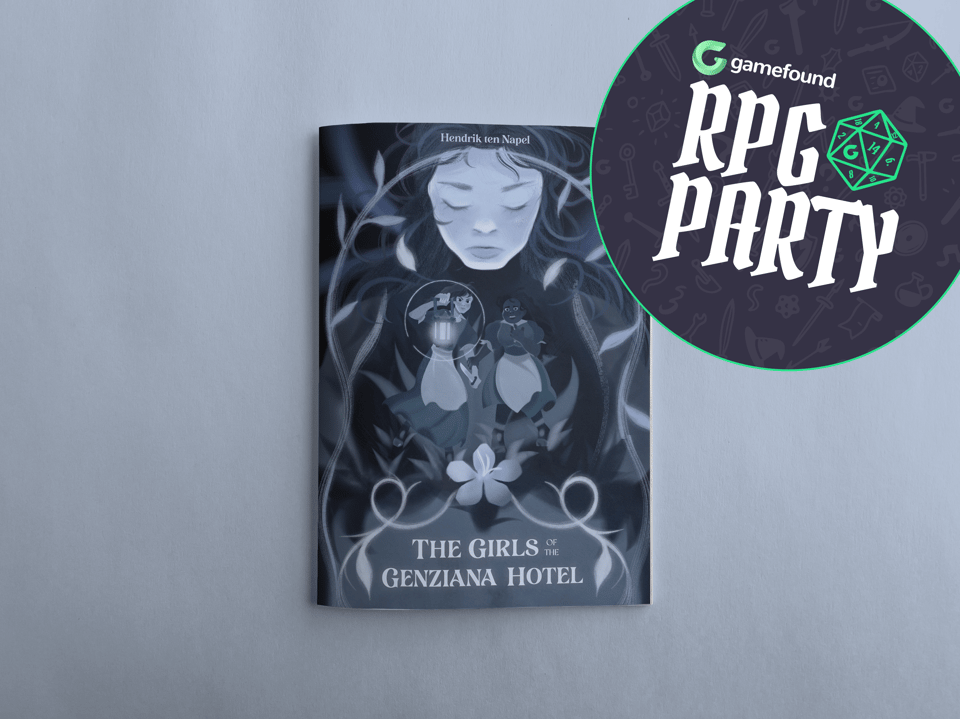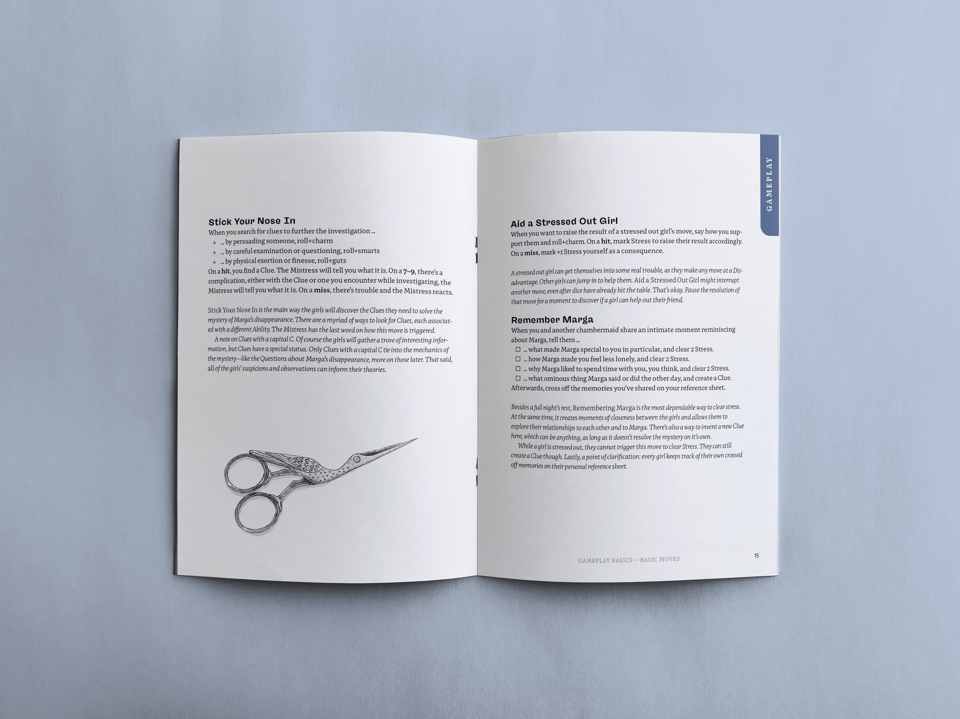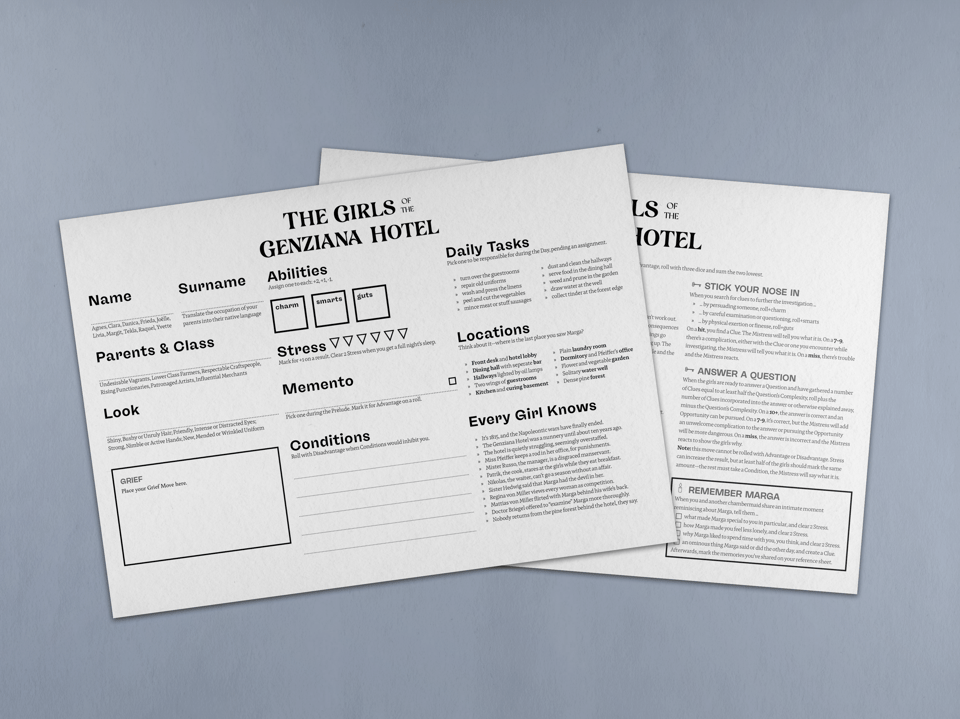The best playtests probably aren't run by the designer of the game

News out of the dark!
I don’t dare to check when I last send out a newsletter, but it’s been a while. What happened? Well, most importantly I started prepping for a crowdfunding campaign. I wanted to finish another round of playtesting, edit and lay out the game, commission some art, write social media threads, design assets for the preview page, and basically be done before making anything public. And I did!
As some of you may have guessed, I’m looking to produce a physical release of The Girls of the Genziana Hotel, my gothic horror mystery game about nineteenth century chambermaids. If you’re unfamiliar, the game is all about Marga, the boyish girl with the wild curls. She’s a chambermaid at the hotel—just like you. When Marga goes missing one night, leaving behind little more than a bloody stocking, it’s up to you to find out what happened to her. Nobody else seems to care.

Starting today, you can give the campaign a follow. That means you’ll get notified once The Girls of the Genziana Hotel starts funding later this year.1
But that’s not all I wanted to talk about today.
Releasing an ashcan
As a Powered by the Apocalypse game, The Girls of the Genziana Hotel started out with a character sheet, a set of basic moves, and a couple of pages of GM materials. The rest of the game was in notes on my laptop and, well, in my head. I ran my first test by playing through a full campaign with a local group, making adjustments each session. What I ended up with became the ashcan version that went online almost a year ago.
As a 50 page, fully laid-out zine, it looked a little too fancy to really be an ashcan, but it certainly was one in spirit. The rules were complete, but they still needed a lot more testing. Key, for me, was that the ashcan communicated what I thought was the core of the game, even though its specifics would probably still change.

Because change they did. My very next session of playtesting already turned up adjustments. I was also lucky enough for other designers and players to latch onto the game and run their own campaigns with the ashcan. Since The Girls of the Genziana Hotel is also Carved from Brindlewood, it could count on plenty of enthusiasm from the fans of the system. For that I’m very grateful.
The advantage of not being there
It was at the tables where I neither played nor facilitated that the game—and my explanation of it—saw its most valuable tests. I wasn't there to make up for any holes in my text or ambiguities among the rules. Through the feedback from these tables, I got to see beyond the game in my head and experience what I had actually written down.
The questions facilitators asked me while getting their head around the game have directly influenced how it’s explained, and several players’ encounter with the game’s moves motivated me to take another look at their wording.
Powered by the Apocalypse games are hard work! I knew that going in—it’s a bit of a cliché among fans of the design philosophy that games like these are more intricate that they look. I certainly experienced that complexity while designing one. My energies were focused on making incrementally smaller changes, like building a ship in a bottle, or, I guess, a hotel out of match sticks.
Desire for individuality
During the Prelude of the game, the players quickly sketch out characters with just a couple of facts: their nationality, their class, and as much description of their look as a uniform will allow. The most important bits characterization are not directly about them, but about how they relate to Marga and her disappearance: they’re supplied with a Memento—one of the belongings Marga left behind—and a separate card with their so-called grief move on it, face down.

After their first session, one group let me know they would've liked to know a bit more about their girls going in. The game already offered a couple of opportunities for elaboration down the line, so I didn't mind it too much. Even so, the comment stayed with me. What could’ve prompted it, exactly? Maybe the players desired something a little more individual? It was true that the most interesting aspects of their character were relational instead of personal.
Something of a cosmic accident
I was reminded of that desire when another tester told me about the moment their girl stressed out. A bit of context: when a girl maxes out their stress for the first time, they reveal their grief move and finally get to know both how grief will make their life harder and what unique ability it offers them. When it happened to this player, the GM asked what it looked like, and the she took a moment to narrate a flashback that gave context to her breakdown.
Grief is the most individual mechanic that the girls deal with. Each of them reacts differently and gains a different move. The flashback that playtester described lend extra weight to the moment at which her girls grief unlocked and became an active force in the story. I liked that a lot—every table should experience moments like that. So that night, I wrote a prompt for each grief move. It would be added to the back of the card. From now on, if a girl stressed out, time would stop and the story would, for one intense moment, be all about her while she answered her grief’s prompt.
I'm fairly positive this bit of design is something of a cosmic accident. Two groups played the game without me, each in their own way, bringing their own culture of play to the hotel. Two testers shared their experience with me, and inside of me, their comments harmonized. In my most sentimental moments—and this is one of those—I'm amazed by that.
It's safe to say that this won't be the last time I release an ashcan.
That's it for now,2
Hendrik ten Napel
Probably August, or the start of September. The campaign will be part of Gamefound’s RPG Party, an initiative to help designers launch great campaigns for role-playing games. It has provided me with tips, workshops, and a community of others who are often, like me, doing this for the first time. ↩
I expect to return to a more regular schedule of writing. Maybe not biweekly, though. Nevertheless, I have several concepts brewing. I'd like to write my first ever big review soon, about The Last Caravan, a game that threw me for a real loop. And I also have a bunch of notes relating to play, amateurism and art. The idea for that article started to snowball after I read an amazing essay by David Graeber called What's the Point If We Can't Have Fun? So this is it for now, but I hope to get back to you soon! ↩